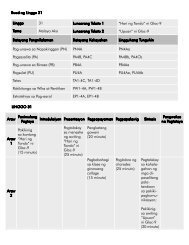Lesson 1 How Others See Me
LP_Second_Quarter_Grade_7_English - baitang7
LP_Second_Quarter_Grade_7_English - baitang7
- No tags were found...
You also want an ePaper? Increase the reach of your titles
YUMPU automatically turns print PDFs into web optimized ePapers that Google loves.
MISCELLANEOUS PAPERS ON MAT<br />
WEAVING IN THE PHILIPPINES:<br />
Mat Industry in Apalit, Province of Pampanga, Luzon<br />
Patricio C. Gozum<br />
There are two principal causes for the development of mat industry in Apalit : first is the supply of labor, and second,<br />
the proximity of material. 1. _____ industry is appropriately called home industry of the Apalit mothers and women. In<br />
general, 2. _____ girls learn the job at a very early age. It has been the custom there, especially among the poor and<br />
middle classes, with the exception of the very few rich families, that 3. _____ woman who does not know how to<br />
make mats is very lazy and is not one whom the Apalit young men regard with much respect. Thus the women who<br />
work primarily to increase 4. _____ family income and those who learn the industry to gain the respect of the people,<br />
form the aggregate labor for the development of 5. _____ industry. The increased demand for mats has recently<br />
encouraged the mat weavers.<br />
The material used is the leaves of the buri palm. The plant grows abundantly in Arayat ; but the facility of<br />
transportation is such that, though 6. _____ plant does not thrive well in Apalit, the weavers can get their materials<br />
easily. The Pampanga River serves as 7. _____ easy means for taking the buri leaves to Apalit with but very slight<br />
expense in comparison with what the weavers get for their finished mats. The green leaves sink, but they can<br />
easily be made to float by using 8. _____ banca (boat) of considerable size across which are fastened bamboo poles<br />
to which in turn are attached the heavy buri leaves. Then they float and are carried along the river by the current<br />
from Arayat down to Apalit where they are distributed to 9. _____ industrious women and girls.<br />
In 10. _____ industry, there is also a division of labor. The women cannot leave the homes and go to Arayat to get<br />
the material, so the men who can save time from their blacksmithing or farming have to go and get it.<br />
Nowadays there are 11. _____ men who usually go to buy the buri leaves and sell them when they go to Apalit,<br />
getting thus some profit for their enterprise. The boys or husbands of 12. _____ weavers take the leaves in bulk to<br />
their homes, strip them from their stems and remove the ribs. The women and children then do the rest of the work<br />
until mats ready for market are made. The buri left in the sunshine until it is dry. As soon as it is dry, it is rolled up so<br />
that 13. _____ curled parts will become straight or flat. Now it is ready to be cut into narrow long strips to be woven<br />
into mats. The mats thus made are called diawa. Oftentimes, they first boil 14. _____ buri with water mixed with<br />
vinegar before they dry, roll, and strip it. The mats thus made with this boiled buri are called linaga, distinguished<br />
from diawa in that the former is very white while 15. _____ latter is greyish.<br />
Retrieved 29 January 2012 from nirc.nanzan-u.ac.jp/publications/afs/.../a74.pdf<br />
Grade 7 English Learning Package 14









